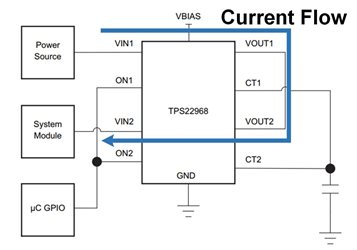Other Parts Discussed in Thread: TPS22912C, TPS22910A, TPS22918, TPS22953
Hi,
On page 19, Figure 34 of TPS22968 datasheet, what happens if VIN2 is at 0V via a pull down resistor to the ground? VIN1 is supplied with +5V, and CTRL sets VOUT = VIN1 through ON1, but ON1 logic comes from VIN2, and VIN2 is connected to ON2 then a pull down resistor to the ground. Is there any reverse current flowing to VIN2 in this situation? I need to use VIN2 as a voltage detection to switch the output to VIN2 whenever there is voltage present at VIN2. When VIN2 is left open and if there is reverse current, charge could build up and invert the logic and stop VIN1 connect to the output.
Thanks



